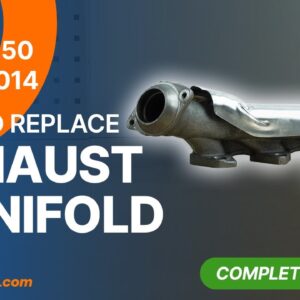Your vehicle’s exhaust system has many parts that work together to remove hot gases from the engine, reduce their emissions, and expel them from the exhaust system. While each part plays a vital role in the system, the exhaust manifold is very important. It enables the exhaust gases to flow into the exhaust system.
What Is an Exhaust Manifold?
The exhaust manifold gathers the exhaust gases from the engine’s cylinder head. It’s attached to the exhaust port on the cylinder head and directs the hot gases to the exhaust pipe. From there, the exhaust gases can proceed to the catalytic converter.
Some exhaust manifolds can store the significant heat generated by the freshly combusted exhaust gases. The accumulated heat combusts a portion of the unburned fuel in the exhaust before the gas flows to the catalytic converter. Exhaust manifold products capable of this feat can help reduce the toxic emissions in the exhaust gases.
Furthermore, the exhaust manifold keeps exhaust gases in the exhaust system instead of escaping into the atmosphere or entering your vehicle’s cabin. Working together with exhaust manifold gaskets to maintain the seal, the manifold protects the occupants of the car or truck from breathing in dangerous fumes.
You can usually find the exhaust manifold between the engine cylinder head and the catalytic converter.
Most V-shaped engines have two exhaust manifolds. Each cylinder bank gets one manifold that handles the exhaust gases produced by that bank.
Inline engines have one cylinder bank. A single exhaust manifold moves their exhaust gases into the exhaust pipe and to the catalytic converter.
Similarly, the majority of rotary engines feature one exhaust manifold. Turbocharged rotary engines have downpipes on the turbocharger’s exhaust side that connect the forced induction device to the exhaust manifold. The downpipes let gases from the exhaust manifold flow to the turbocharger, driving the device to produce boost charges for the engine.
Exhaust Manifold Types
Exhaust manifolds are classified according to a mix of their materials and construction. Here are the most common types of exhaust manifolds according to their material:
Cast Iron Exhaust Manifold
Cast iron exhaust manifolds use iron and are cast into their shapes. Cast iron is inexpensive to manufacture, easy to work with, durable, and can last for a long time.
Most cars and trucks have cast iron exhaust manifolds as stock parts. Modern vehicles prioritize compact size and service life over horsepower and torque. Thus, a cast iron exhaust manifold will usually suffice for everyday driving.
Cast iron comes with drawbacks, such as being heavier than steel. It also becomes brittle and vulnerable to fracturing over time and when exposed to high heat.
Tubular Steel Exhaust Manifold
Tubular steel exhaust manifolds are made up of steel tubes welded together at their intersections. The manifold itself is welded to the cylinder head flange.
Many tubular steel exhaust manifolds feature integrated flex-pipes, enabling independent flexing of the manifold’s parts in response to temperature changes.
This exhaust manifold uses either mild steel or stainless steel. Both types of steel have advantages and disadvantages.
Mild steel is more affordable and doesn’t expand much when heated. It’s highly suited for the flanges of tubular steel exhaust manifolds. However, it doesn’t last as long as sturdier materials.
Stainless steel features superior strength and resistance to corrosion. However, it tends to expand in volume when heated and contract when it cools. Constant and severe expansion and contraction can destroy the fasteners that connect the exhaust system. Stainless steel also costs more.
Tubular steel exhaust manifolds typically have better gas flow than their cast iron counterparts. They’re usually found on performance vehicles, like sports cars and Jeep models.
Tubular steel exhaust manifolds also retain more heat, enabling them to burn more fuel in the exhaust gas. They increase the engine’s horsepower and enhance the vehicle’s performance.
A stainless steel exhaust manifold will pay for more than its cost in terms of its looks, ability to withstand corrosion, and long service life.
Tubular steel exhaust manifolds must resist exposure to external elements like dust, high temperatures, and moisture that lead to rust. Stainless steel manifolds can resist these corrosive elements longer than mild steel. However, extended exposure to high temperatures can change the color of the stainless steel near the cylinder head flange.
Common Reasons For a Cracked Exhaust Manifold
The exhaust manifold can develop many issues that reduce its performance or lead to failure. However, the most common problem is a cracked exhaust manifold.
Tiny cracks form in the fatigued metal. The fractures grow in size until they become holes that release exhaust gases.
Here are the most likely reasons for a cracked exhaust manifold:
Excessive Heat Cycles
The heat cycle refers to a period when an object heats up and cools down. The exhaust manifold goes through numerous cycles where its temperature rises and falls. Eventually, the manifold reaches its limit and cracks.
Age
The older the exhaust manifold gets, the more likely it might fracture. Not only do the repeating heat cycles weaken it, but other factors might also degrade it.
Damaged Exhaust System Hangers
Exhaust system hangers support the weight of exhaust parts. They help the exhaust manifold hold up the rest of the exhaust system.
Unfortunately, exhaust system hangers can break off. Without the assistance of intact hangers, the exhaust manifold is forced to bear the combined weight of the exhaust parts. The manifold itself can crack and fail if it supports too much weight for too long.
Cracked Exhaust Manifold Symptoms
Here are the most common cracked exhaust manifold symptoms:
- Fractures that you can see with the unaided eye.
- Loud noises coming from the exhaust system.
- Reduced fuel efficiency and engine performance.
- Burning smell from the engine bay that might enter the vehicle’s interior.
Any information provided on this Website is for informational purposes only and is not intended to replace consultation with a professional mechanic. The accuracy and timeliness of the information may change from the time of publication.





































